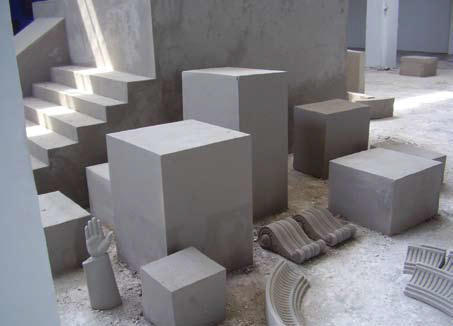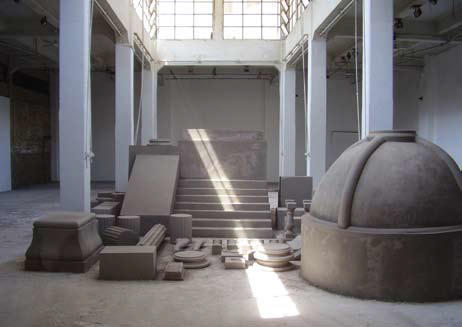
In the spring of 2007, Tarek Zaki spent five days building a sprawling, multifaceted installation of more than thirty plaster and concrete objects. Then, in the factory space of Cairo’s Townhouse gallery, he exhibited the work as if it were something that had just been systematically taken apart. When the show closed, he destroyed everything in a matter of hours.
As of this writing, Zaki is rebuilding the same work — albeit with different materials, on a larger scale, and in a new configuration — for Fort Island, a speck of land in a manmade lagoon that serves as the centerpiece of Dubai’s opulent Madinat Jumeirah resort, which is hosting the second edition of Art Dubai. It’s unclear what the future of the work will be when the fair ends on March 22. Maybe it’ll be destroyed again, maybe it’ll stick around this time, maybe it’ll simply be moved someplace else. Such uncertainty amplifies the already critical ambiguity of a piece that eloquently and hauntingly explores notions of time, history, memorial, and ruin.
Monument X posits the disparate parts of an unknown, unnamed monument as objects of study, wonder, and play. Columns, plinths, arches, domes, a set of steps, and the fragmented limbs of man and animal are carefully arranged, as if the monument had just been dismantled, its pieces awaiting classification tags and a storage container, or as if it had just been discovered, its pieces awaiting patient reconstruction and proper museum-style display. Zaki, the unseen artist, doubles as a time-traveling archaeologist and also, perhaps, as a conceptual prankster with a lingering attachment to formalism (the stark, matte minimalism of his lines and surfaces are as ghostly and evocative as that of Rachel Whiteread’s plaster, resin, and concrete casts). Stripped of all details that might indicate identity and history, and left with only the marks of labor’s wear and tear, Monument X is ultimately a riddle, one that yields no solutions and instead multiplies the questions.
Now, in re-creating Monument X, Zaki is adding another layer of intrigue to a work that toys with space, volume, material, and the permanence of iconic gestures, by emphasizing impermanence, the ease of construction and destruction, mobility, and the various meanings gathered from site and circumstance.
“[When Monument X] was first exhibited at the Townhouse Gallery, in the factory, I turned the space back into a warehouse,” Zaki recalls. “People didn’t expect to see what they saw. It didn’t look like a gallery, and the pieces didn’t exactly look like ‘art.’” Yet by situating the work in a well-known independent art space, off Champollion Street in downtown Cairo, Zaki surely threw out a wealth of possible narratives, connecting the dots between Pharaonic relics, noted Egyptologists, colonial architecture, and civic space.
After all, you’ve seen monuments like this before. They stand in plazas and public squares, marking out territory in space and time. They usually pay direct tribute to statesmen and offer more oblique references to revolutions, independence movements, the new political orders established by postcolonial regimes. They persist for the purpose of inspiring civic pride and to remind all who pass that history was made there. They demand a measure of respect — unless, of course, they’re knocked down and destroyed to signal the end of an era and the negation, or rewriting, of its history. In these monuments, a leader, typically male, is represented in cast concrete or chiseled stone. Depending on the century of issue, he’s either standing or astride a horse, with arm and index finger extended either up or over, pointing the way forward, indicating the path of progress, and promising a viable future.
To move Monument X from Cairo to Dubai — and from a nonprofit art space to a commercial art fair — triggers an entirely different set of generative stories. Gone is the proximity to old museums and mausoleums of ancient culture. In Dubai, Monument X has the potential to comment on the death of the nation-state (and its nineteenth-century statues of heroes on horseback) and the rise of more nebulous, postdemocratic situations (in which figurative historical monuments are likely to be at best re-created for nostalgia, at worst relegated to theme parks).
Monument X is intimately tied to Zaki’s earlier body of work, Time Machine: Remembering Tomorrow, an installation of sculptures encased in glass vitrines that imagined the spent remains of today’s warfare — military-issue keyboards and data keys, soldiers’ helmets, missiles — as the novel artifacts of tomorrow’s antiquities museums.
“The two projects both deal with the icon. They both ‘look back’ at the present and try to examine history,” says Zaki. “The idea of disintegration is evident in both, [as is] the playful approach. If Time Machine: Remembering Tomorrow deals with how museums represent the past then Monument X deals with how monuments try to represent history and how we perceive it.”
Zaki, who was born in Saudi Arabia, went through five years of art school at Helwan University in Cairo. It was the kind of place where art the history of art ended with Picasso and Matisse, Zaki laughs; where installation and video never happened; and where figuration and realism reigned. (Though as for those figures — students copied draperies rather than human models.) Still, the spark for his latest works came from a source rather removed from the faculty studio.
“The war in Iraq was the first war I witnessed as an adult,” he says. “I was a boy when the first Gulf War took place. The war in Iraq was too surreal. People were watching television, following the news, and I felt like it was the World Cup or the Olympic Games. It felt so unreal, yet so threatening. I saw what destruction could be, how millions of people could just vanish, and how a nation could become history. Monument X was triggered by the war in Iraq and many other factors…. The whole region, maybe the whole world, is going through a difficult period of instability. Egypt is facing an unknown political future, and so is Lebanon,” he notes. “Deconstructing the monument seemed like the right thing to do.”
What sets Zaki’s approach to political concerns apart from his peers’, however, is his insistence, first, on the very material presence of solid, three-dimensional objects at a time when many artists tackling historical rupture are opting for immaterial gestures or ephemeral inventions; and second, on the connection between his work and a wide-ranging art-historical discourse. As an artist of critical strategies, Zaki is almost entirely self-taught, accumulating knowledge through studio residencies, fellowship grants, and internet research. Yet he situates the questions of his practice well within a sculptural lineage.
“Sculpture in general, whether casting or molding or chiseling, embodies its own history,” he explains. “You look at Venus or Ramses or a work by Tàpies or Cy Twombly, and they all seem to share one long story. These pieces of stone or marble are left by their creators (whether Egyptians, Romans, or Mayans) like evidence or proof of their existence. The physical existence of that object or sculpture in the void is the present, the embodiment of now.
“A photograph can record that existence, but I’m more interested in the existence itself that is evident in every layer or surface of the object. I try to create objects that speak for all tenses: past, future, and present. I am interested in objects that are timeless…. Time is such an elusive thing. Time is also everything…. We [try] to fight or tame nature, climate, gravity, but when it comes to time, we are clueless.
“Archaeologists are endlessly trying to solve the riddles of the past. We don’t stop digging [into] the ground, to know more about who we are, where we came from, and where we are going to, to quote from Gauguin’s painting. Some archaeologists try to tell objective histories, others [more subjective accounts]. With all of that, we are left with a huge gap between what we know and what actually took place. That gap needs to be filled, and so every one of us has his own version of history. Monument X gives the viewer the chance to make his own version of the monument, to play the archaeologist, to solve the puzzle and put the pieces together.”
